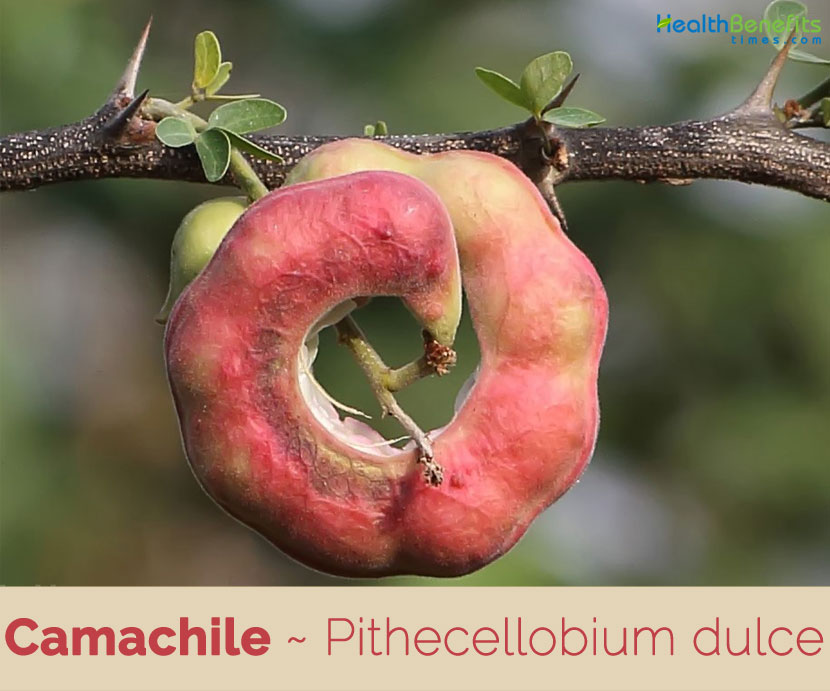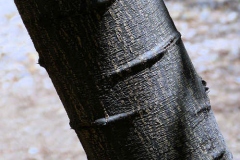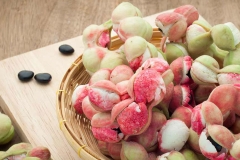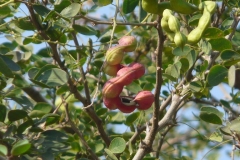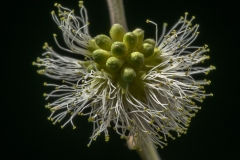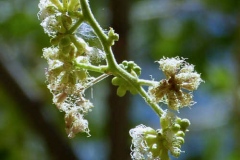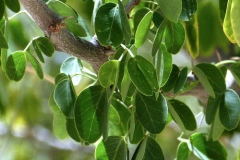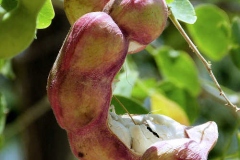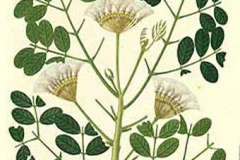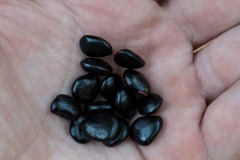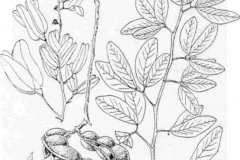| Camachile Quick Facts |
| Name: |
Camachile |
| Origin |
Pacific Coast and adjacent highlands of Mexico, Central America, and northern South America |
| Colors |
Green tinged red, turning bright rose or bright red as they ripen, and reddish-brown after dehiscence |
| Shapes |
Distinctive in shape and colour being spirally curved or coiled into 1-2 circles, noticeably constricted between the seeds. The unripe pods are fleshy, becoming dry and papery after opening |
| Flesh colors |
Pinkish red, while others are snow white |
| Taste |
Sweet to taste, musky and acidic, simply resembling desiccated coconut meat |
| Health benefits |
Beneficial for diarrhea, dysentery, hemoptysis, chest congestion, Diabetes, internal ulcers, eye infections, Jaundice, swelling of the eyelid, Anorexia, s |
Pithecellobium dulce commonly known as Blackbead, Camachile tree is a genus of flowering plant in the pea family Fabaceae that is inhabitant to the Pacific Coast and adjacent highlands of Mexico, Central America, and northern South America. It is an introduced species and extensively naturalized in the Caribbean, Florida, Guam, India, Bangladesh, Sri Lanka, Pakistan, Thailand and the Philippines. It is considered an invasive species in Hawaii. Known by several other common names such as Blackbead, Camachile tree, Madras thorn, Manila tamarind, Opiuma, Sweet inga, Manilla Tamarind, Guayamochil, Monkey Pod and much more, in the region of Hawaii, it is considered as an invasive species. The genus name is derived from the Greek words pithekos (an ape) and lobos (a lobe), alluding to the pods, shaped like the human ears. This species was named and described botanically in 1795 from Coromandel, India, where it had been introduced. The specific name, meaning sweet, doubtless refers to the edible seed pulp.
Plant Description
Camachile is a small to medium-sized thorny, multiple-stemmed, deciduous tree or sometime forming only a bush, but often forming a branchy tree with an irregular rounded crown and flexuous and pendulous branches that grows up to 15-20 m in height with a dbh of 30-50 cm, or even 100 cm forming impenetrable thickets. The plant is found growing in dry tropical and subtropical forest, thorn scrub, matorral, secondary savannah, coastal dunes and in the eco-tone habitat between mangrove and lowland forest, and in Mexico it is frequently seen growing on roadsides and in the urban environment. The plant prefers extremely rocky, shallow and skeletal soils, primarily of volcanic origin in areas where soils have often suffered severe abuse through slash and burn agriculture, desiccation and erosion. It is also found along river banks on alluvial soils and sands. It prefers well-drained soils but can grow on heavier clays, including black cotton vertisols. It is known to tolerate moderate salinity in areas with a high brackish water table
A few slender whip-like branches often straggle well beyond the rest of the crown. Crown is spreading but irregular. Trunk is short, about 1 m high, with crooked branches and somewhat shiny branchlets. Bark is grey and smooth in young trees, turning to slightly rough and furrowed in old trees. Bark exudes reddish-brown gum when injured.
Leaves
Leaves are bipinnately compound with a pair of pinnae, each with two leaflets that are kidney shaped and dark green in color. The leaflets are 25-56 mm long and 9-32 mm wide, obliquely elliptic or oblong elliptic with 4-7 pairs of pinnate veins, deep olive green above, paler grey-green below, with small glands, 0.3-0.8 mm high and 0.4-0.7 mm in diameter, at the tip of the petiole and the tip of the pinnular rachis. Spines are present in pairs at the base of the leaf. New leaf growth and shedding of old leaves occur almost simultaneously, giving the tree an evergreen appearance.
Flowers
Flowers are grouped in small, dense, sub-spherical heads, 7-12 mm in diameter, with 20-30 flowers per head, the heads arranged in fascicles of 2-4 in axils of leaves. The flowers are pale whitish-green and the stamen filaments are white. There are 5 sepals and 5 petals fused into a tube, with 22-42 stamens per flower, also basally united into a staminal tube. Flowering normally takes place from March to April.
Fruit
Fertile flowers are followed by fruits that are distinctive in shape and color being spirally curved or coiled into 1-2 circles, noticeably constricted between the seeds. They are initially green tinged red, turning bright rose or bright red as they ripen, and reddish-brown after dehiscence. The unripe pods are fleshy, becoming dry and papery after opening. The pods open along both sides to reveal 8-12 seeds which persist after the pods open, attached by the fleshy white, pale pink or occasionally red, aril. The seeds are shiny black, compressed, lentiform, and 7-13 x 6-11 x 2-4 mm in size.
Traditional uses and benefits of Camachile
- Leaf is used as an abortive and as a digestive.
- Bark is used in a decoction as an enema in India.
- It can relief convulsions, inflammations, and venereal sores.
- It also functions as remedy for diarrhea, dysentery, hemoptysis, chest congestion, and internal ulcers.
- Leaves can be used as a plaster to allay pain even from venereal sores, and can relieve convulsions.
- Paste made from the leaves is applied externally to treat muscular swellings caused by some inflammations.
- Leaves together with salt can cure indigestion and, in larger doses, can also induce abortion.
- Bark of the root is a good remedy for diarrhea and dysentery.
- Bark is used medicinally as a febrifuge.
- Fruit pulp is taken orally to stop blood flow in case of Haemoptysis.
- Seed juice is inhaled into the nostrils against chest congestion and pulverized seeds are ingested for internal ulcers.
- Bark is used as an astringent for dysentery in India.
- It is said to have been used as an antipyretic in India, used for eye inflammation, although an anecdote from Sri Lanka claims the bark consists of a substance that causes eye infections and swelling of the eyelids.
- The Huastec people of northern Veracruz and San Luis Potosí in Mexico used different parts of the tree to treat gum ailments, toothache and cancer.
- Leaves are said to be used in a poultice with alcohol to treat bile, as well as being used to prevent abortions/miscarriage, although the leaves are also said to be used to cause abortions.
- Pulp from the fruits is said to be astringent and hemostatic, and used for hemoptysis.
- Ground seed is sometimes traditionally used to clean ulcers.
- Non-specified parts of the plant are said to be used extract is also used against hemorrhages, chronic diarrhea, and tuberculosis.
- Fruit pulp is taken orally to stop blood flow in case of haemoptysis.
- Seed juice is inhaled into the nostrils against chest congestion and pulverized seeds are ingested for internal ulcers.
- In Eastern Nepal, parts of the camachile treat fever, the stem combats dysentery, and the leaves help with intestinal disorders.
- Pithecellobium Dulce is used to counter gum diseases.
- It provides relief from Toothache.
- It inhibits the blood loss within the body to avoid the risk of Internal Bleeding.
- Pithecellobium Dulce leaves are effective in combating against Gallbladder Disease.
- It is fruitful in curing Tuberculosis.
- Grounded seeds are optimal for healing ulcers.
- It is potentially advisable for treating sexually transmitted diseases.
- It is potent in reducing Fever.
- It regulates the oxygen supply to the Brain cells and prevents Brain Stroke.
- It inhibits the growth of cancer cells. Therefore, it offers comfort to the patient debilitated with Prostate Cancer and Colon Cancer.
- It is enriched with Thiamine content which overcomes from Stress.
- It induces the appetite to combat Anorexia.
- It is used to reduce high cholesterol.
- It lowers the blood sugar levels that are beneficial for curing Diabetes.
- It suppresses the Inflammation within the body.
- It is recommended for curing Jaundice.
- It is fruitful in curing Conjunctivitis.
Ayurvedic Health benefits of Camachile
- Irritable Bowel Syndrome: Steep few fresh Pithecellobium Dulce bark in 200 ml of boiling water for 10 minutes. Allow it to cool. Drink this decoction once a day to reduce the symptoms.
- Pain: Rub Pithecellobium Dulce leaves against a hard surface. Apply it on the affected to reduce the pain.
- Indigestion: Boil few Pithecellobium Dulce leaves in 150 ml of water for 5 minutes. Add a pinch of Salt in the water. Boil it for another 5 minutes.
- Ulcers: Take Pithecellobium Dulce leaves and crush them against a hard surface. Apply these leaves over the wounds to get relief.
- Dysentery: Simmer Pithecellobium Dulce bark in 150 ml of boiling water for 5 to 10 minutes. Strain it off. Drink it cool to get rid off Dysentery.
- Eczema: Make a decoction by boiling Pithecellobium Dulce bark in 200 ml of water for 10 minutes. Strain it off. Drink this decoction daily to reduce Eczema.
- Panophthalmitis: Prepare an infusion by steeping Pithecellobium Dulce leaves in 150 ml of boiling water for 10 minutes. Boil till it reduces to half. Strain it off. Consumption of this infusion regularly once a day can prevent Panophthalmitis.
- Leprosy: Boil Pithecellobium Dulce leaves in 200 ml of water for 15 minutes. Allow it to cool. Daily consume a glass of it to get best results.
- Toothache: Prepare a decoction by boiling Pithecellobium Dulce leaves in 150 ml of water for 5 to 10 minutes. Strain it off. Gargle daily in the morning to combat against a toothache.
- Fever: Consume a glass of Pithecellobium Dulce bark decoction to alleviate Fever.
Culinary uses
- Flesh surrounding the seeds can be eaten raw, cooked, or made into drinks.
- Seeds can also be eaten raw or used as an ingredient in curries.
- Flesh can be eaten raw, boiled or made into a refreshing beverage that is suggestive of lemonade
- Seed pods contain a sweet and sour pulp which is eaten raw in Mexico and India as an accompaniment to various meat dishes and used as a base for drinks with sugar and water.
- It is also used in making some candy, pastries, and desserts.
Other Facts
- Edible oil can be obtained from the seeds, which can also be used in making soap.
- Bark is a source of yellow dye, tannin, and gum.
- Seeds and leaves are also sources of tannin.
- Wood is not of superior quality but can still be used in light construction and for poles.
- Wood is used locally for construction, paneling, boxes, crates, agricultural implements, and cart wheels.
- Wood is used as a domestic fuel in many areas where firewood is in short supply and as fuel for brick kilns in India.
- Flowers of P. dulce are a high quality nectar and pollen source producing excellent quality honey.
Precautions
- Sap can cause eye irritation and skin welts.
- Bark contains irritating substances, which can cause eye infections.
- Handling plant may cause skin irritation or allergic reaction.
- Plant has spines or sharp edges; use extreme caution when handling.
- Bark contains irritating substances, which can cause eye infections.
- Avoid use during pregnancy and breast feeding.
References:
https://www.itis.gov/servlet/SingleRpt/SingleRpt?search_topic=TSN&search_value=26871#null
http://www.hear.org/pier/species/pithecellobium_dulce.htm
https://npgsweb.ars-grin.gov/gringlobal/taxonomydetail.aspx?id=28697
https://pfaf.org/user/Plant.aspx?LatinName=Pithecellobium+dulce
https://www.cabi.org/isc/datasheet/41187
https://plants.usda.gov/core/profile?symbol=PIDU
https://en.wikipedia.org/wiki/Pithecellobium_dulce
https://hort.purdue.edu/newcrop/duke_energy/Pithecellobium_dulce.html
http://tropical.theferns.info/viewtropical.php?id=Pithecellobium+dulce
https://indiabiodiversity.org/species/show/266702
https://wiki2.org/en/Pithecellobium_dulce
http://www.theplantlist.org/tpl1.1/record/ild-243
https://keyserver.lucidcentral.org/weeds/data/media/Html/pithecellobium_dulce.htm
http://www.fao.org/tempref/docrep/fao/010/ai387e/ai387e05.pdf
https://uses.plantnet-project.org/en/Pithecellobium_dulce_(PROSEA)
https://gd.eppo.int/taxon/PIFDU
https://pdfs.semanticscholar.org/736f/a2773b4de70292657d273f72e85d27f8283b.pdf
http://www.flowersofindia.net/catalog/slides/Madras%20Thorn.html
Comments
comments


